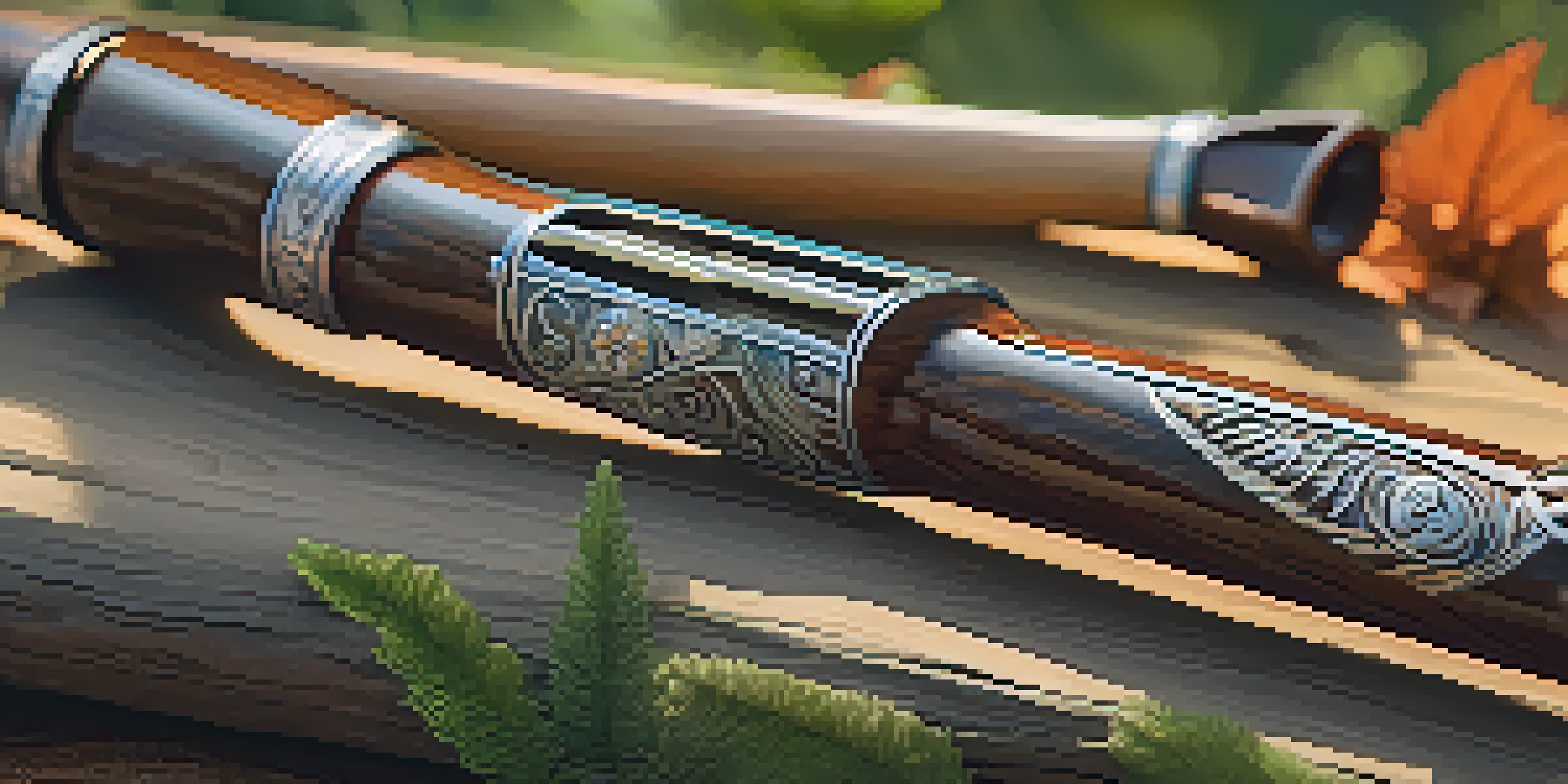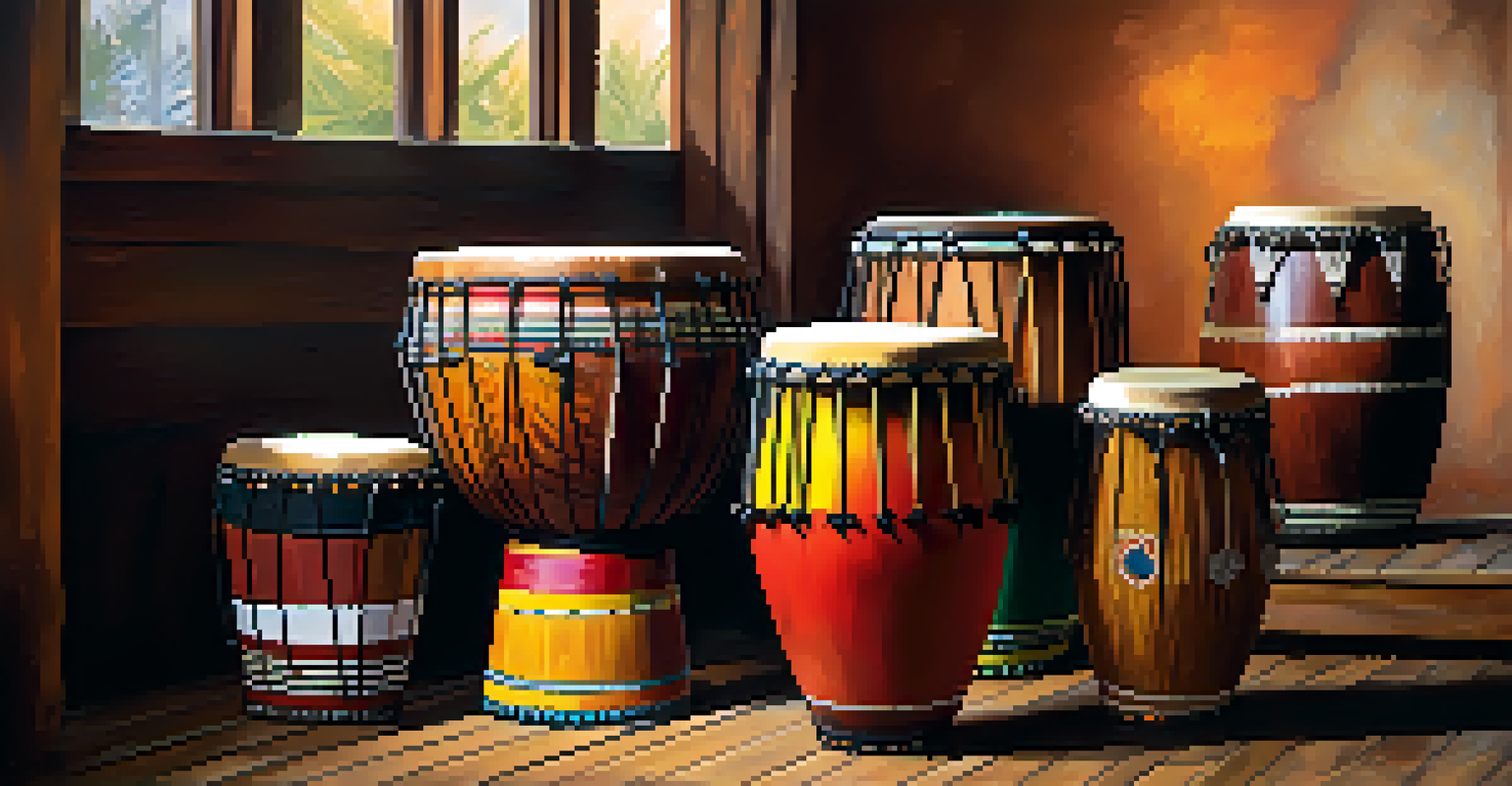Cultural Significance of Carved Instruments Across Cultures

Understanding Carved Instruments and Their Origins
Carved instruments have a rich history that dates back thousands of years, often reflecting the unique characteristics of the cultures that create them. From Native American flutes to African drums, these instruments are not just tools for music; they are embodiments of cultural identity. Each carved piece often tells a story, with intricate designs symbolizing the beliefs, values, and traditions of its makers.
Music is the shorthand of emotion.
These instruments are crafted from various materials, such as wood, bone, and sometimes stone, with each material offering a different sound quality. The process of carving itself can be a spiritual or communal activity, often involving rituals that connect the artisans with their heritage. This deep-rooted connection provides insight into how music and craftsmanship intertwine in cultural practices.
Moreover, the significance of these instruments often transcends music, acting as a means of communication, storytelling, and even healing. By understanding the origins and craftsmanship behind carved instruments, we can appreciate their role as vital components of cultural expression.
Cultural Roles of Carved Instruments in Different Societies
In many cultures, carved instruments play a pivotal role in rituals and ceremonies. For example, the didgeridoo of the Aboriginal Australians is not only an instrument but also a sacred object used in spiritual practices. Such instruments can serve as a bridge between the physical and spiritual worlds, marking significant life events like births, marriages, and funerals.

In African cultures, carved instruments like the djembe drum are often central to community gatherings, where music fosters connection and unity. The rhythms created are deeply tied to cultural identity, often passed down through generations. This practice highlights how music can be a communal activity, encouraging participation and engagement.
Cultural Identity Through Carved Instruments
Carved instruments embody the beliefs and heritage of communities, serving as powerful symbols of cultural identity.
Additionally, in Asian cultures, instruments like the bamboo flute are often associated with specific folklore and storytelling traditions. They are used to narrate stories, create ambiance, and evoke emotions, reinforcing the importance of oral history in preserving cultural heritage. Thus, carved instruments serve not just as musical tools but as vital links to cultural narratives.
The Art of Carving: Techniques and Styles Across Cultures
The art of carving instruments varies significantly across cultures, with each region employing unique techniques and styles. For instance, Polynesian carving is known for its intricate motifs that often depict deities and ancestors, while Native American artisans may incorporate symbols that represent nature and spirituality. This diversity illustrates how artistic expression is influenced by environmental, social, and spiritual factors.
In every culture, music is a reflection of the people who create it.
Many cultures rely on traditional tools and methods passed down through generations, creating a sense of continuity and community. The hands-on nature of carving allows artisans to connect with their heritage and produce instruments that resonate with their cultural narrative. Using local materials not only contributes to the uniqueness of each instrument but also reinforces a sustainable approach to craftsmanship.
The choice of design also plays a crucial role, as it often reflects the beliefs and values of the community. For example, some cultures incorporate animal motifs that symbolize strength or protection, while others might include geometric patterns that represent harmony. This artistic language enriches the cultural significance of carved instruments and serves as a visual representation of their stories.
Carved Instruments in Contemporary Music and Art
In today’s globalized world, carved instruments are experiencing a resurgence in contemporary music, blending traditional sounds with modern genres. Musicians are increasingly turning to these unique instruments to create fresh, innovative sounds that honor their cultural roots. This fusion not only keeps the traditions alive but also introduces them to wider audiences.
Artists are also exploring the visual aspects of carved instruments in their work, highlighting their aesthetic beauty and cultural significance. Exhibitions showcasing carved instruments celebrate their craftsmanship, allowing people to appreciate the artistry behind each piece. This merging of music and visual art reinforces the idea that cultural heritage can be expressed in multiple forms.
Preservation of Traditional Techniques
Efforts to pass down traditional carving techniques are crucial for maintaining cultural heritage in a rapidly changing world.
Additionally, the popularity of world music has led to collaborations between artists from different cultures, using carved instruments as a way to bridge gaps and foster understanding. These musical partnerships often result in exciting new sounds while promoting cultural appreciation and respect. Through contemporary interpretations, carved instruments continue to play a vital role in shaping the global music landscape.
Preservation of Traditional Carving Techniques
As modernity advances, the preservation of traditional carving techniques has become increasingly important. Many artisans are recognizing the need to pass down their skills to ensure that their cultural heritage is not lost. Workshops and programs are being established worldwide, teaching younger generations the art of carving as a way to keep these practices alive.
Moreover, the rise of digital media has opened new avenues for sharing knowledge about traditional carving techniques. Online platforms allow artisans to showcase their work and share tutorials, reaching a global audience eager to learn about different cultures. This accessibility fosters an appreciation for the art form and encourages cross-cultural exchange.
Organizations dedicated to preserving indigenous arts are also playing a crucial role in safeguarding these techniques. By providing resources and support to artisans, they help ensure that the craftsmanship associated with carved instruments continues to thrive. Ultimately, these efforts highlight the importance of maintaining cultural integrity in a rapidly changing world.
The Role of Carved Instruments in Cultural Identity
Carved instruments are powerful symbols of cultural identity, often representing the essence of a community’s beliefs and values. For many, these instruments serve as a tangible connection to their ancestry and heritage. Whether it’s a wooden drum or a beautifully crafted flute, each piece carries the weight of cultural significance and pride.
In numerous instances, the revival of traditional music and instruments has become a form of cultural resistance. Communities facing globalization are turning to their carved instruments to reclaim their identity and heritage. This resurgence not only strengthens community bonds but also instills a sense of belonging among members, fostering pride in their unique cultural narratives.
Contemporary Fusion and Global Appeal
The resurgence of carved instruments in modern music fosters innovation while honoring cultural roots, bridging gaps between diverse communities.
Furthermore, as societies become more diverse, carved instruments can serve as a bridge, promoting understanding and appreciation among different cultures. They can be showcased in multicultural events, allowing people to experience the richness of various traditions. In this way, carved instruments not only represent cultural identity but also encourage dialogue and connection across communities.
Conclusion: The Lasting Impact of Carved Instruments
The impact of carved instruments on cultures worldwide is profound and far-reaching. They are not merely objects; they encapsulate stories, traditions, and the essence of the people who create and use them. By understanding their cultural significance, we gain insight into the values and experiences that shape diverse communities.
As we continue to celebrate and honor these instruments, it is essential to advocate for their preservation and the traditions surrounding them. Supporting artisans and promoting cultural exchange can help ensure that these beautiful expressions of heritage endure for future generations. It becomes our collective responsibility to appreciate and protect the artistry behind carved instruments.

In a world that often feels disconnected, carved instruments remind us of our shared humanity and the power of music to unite us. As we explore the melodies and rhythms of different cultures, we enrich our own lives, fostering a deeper appreciation for the diverse tapestry of human experience.